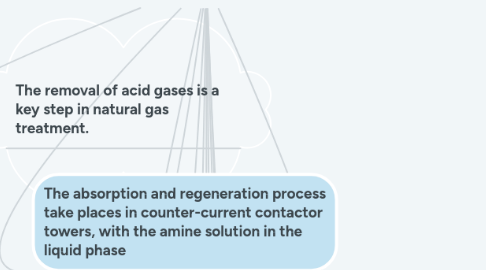
1. The troubleshooting process into a series of steps that include a lean amine sample anaylsis, collection of process data, calculation of the rich amine loading, measurement of the pressure drops, and an infrared scan, a detailed analysis can be conducted to find the prob- lem and fix it.
2. Analyze an infrared scan
2.1. Thermal imaging is a useful tool for gaining insight into the internal operations of process equipment.
2.1.1. The acid-gas absorption reaction is exothermic, and the temperature in the absorber can reveal the progress of the reaction in the tower.
2.1.2. An ideal profile has a vertical temperature gradient
2.1.3. The maximum temperature indicates where the bulk of the reaction occurs, (lower third of the column); the gas is polished to the required specifications( top two-thirds.)
2.2. Temperature profile is a constant horizontal temperature.
2.3. In a trayed tower, a uniform temperature distribution indicates that the trays are intact and undamaged; in a packed tower, it indicates good liquid distri- bution.
2.4. The maximum temperature within the column should not exceed 185°F (85°C) in order to prevent flashing of cor- rosive acid gas
3. The rich-amine loading calculation helps in checking that the amine circulation rate is optimo for the absorption process.
4. Parameters to be evaluated include:
4.1. Maximum absorber temperature, which should not exceed 185°F
4.2. Regenerator overhead temperature and pressure
4.3. Lean amine temperature, which should be 10°F higher than the inlet gas temperature in order to prevent hydrocarbon condensation
4.4. Inlet and treated gas compositions
5. Collect detailed process data
6. Heat-stable amine salts are ionic species that are considered solvent contaminants
6.1. They are designated as heat-stable because the reaction that forms the salt species is not thermally reversible.
7. The key parameters to be checked are:
7.1. Heat-stable amine salt concentrations, which are measured by ion chromatography
7.2. Amine concentration, measured by titration or gas chromatography
7.3. Soluble-metal concentrations, measured by inductively coupled plasma atomic emission spectroscopy.
7.4. Lean-amine acid-gas loading, measured by titration
7.5. Lean-amine acid-gas loading indicates the number of moles of acid gas per mole of amine present in the lean sol- vent fed to the absorber.
8. The absorption and regeneration process take places in counter-current contactor towers, with the amine solution in the liquid phase
9. The removal of acid gases is a key step in natural gas treatment.
10. The horizontal temperature profile of each tray should remain relatively constant under normal operating conditions
11. Flooding at Plant Alpha Plant Alpha is a midstream natural gas treating facility with four identical amine absorption trains for CO2 and H2S removal
11.1. The objectives of the troubleshooting efforts were to identify the cause of flooding on Trains A and B
11.1.1. A high concentration of amine is a risk factor for foaming and was noted as a possible cause of problems in these two units
11.1.2. High levels of metals in solution can exacerbate foam, but the levels detected metals eliminate the foam formation as a cause
11.1.3. Infrared scanning of train B indicated a maximum absorber temperature of 140 °F. If the temperature exceeds 185 F, the absorption balance reaction could be reversed and cause the acid gas to quickly exit the amine.
11.1.3.1. The effect looks similar to foaming and can result in a reduction in acid gas removal.
